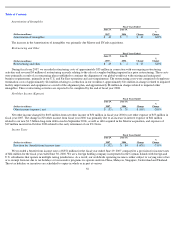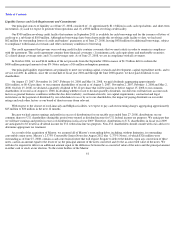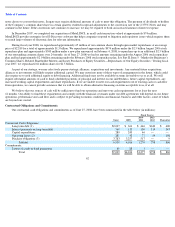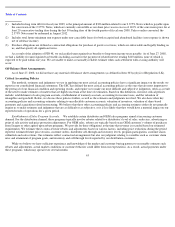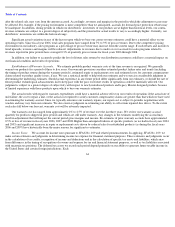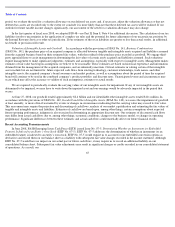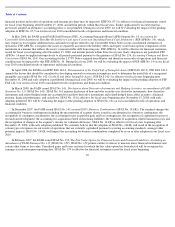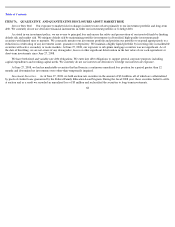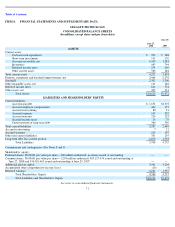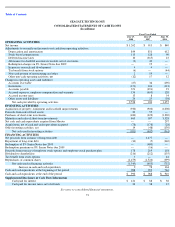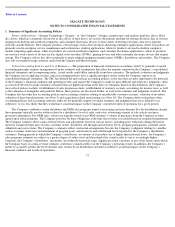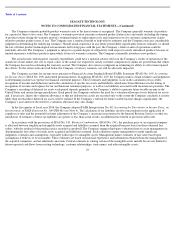Seagate 2007 Annual Report Download - page 67
Download and view the complete annual report
Please find page 67 of the 2007 Seagate annual report below. You can navigate through the pages in the report by either clicking on the pages listed below, or by using the keyword search tool below to find specific information within the annual report.
Table of Contents
financial position and results of operations and earnings per share may be impacted. EITF No. 07-5 is effective for financial statements issued
for fiscal years beginning after December 15, 2008, and interim periods within those fiscal years. Earlier application by an entity that has
previously adopted an alternative accounting policy is not permitted. During fiscal year 2009, we will be evaluating the impact of the pending
adoption of EITF No. 07-5 on our fiscal year 2010 consolidated results of operations and financial condition.
In May 2008, the FASB issued FASB Staff Position (FSP), Accounting Principles Board (APB) Opinion No. 14, Accounting for
Convertible Debt Instruments That May Be Settled in Cash upon Conversion (Including Partial Cash Settlement ) (FSP APB No. 14), which,
may require us to recognize additional non-cash interest expense related to our Convertible Senior Notes in our consolidated statements of
operations. FSP APB No. 14 requires the issuer to separately account for the liability (debt) and equity (conversion option) components of the
instrument in a manner that reflects the issuer’s nonconvertible debt borrowing rate. FSP APB No. 14 will be effective for financial statements
issued for fiscal years beginning after December 15, 2008, and interim periods within those fiscal years. Early adoption is not permitted. FSP
APB No. 14 must be applied retrospectively to all periods presented pursuant to the guidance of SFAS No. 154, Accounting Changes and Error
Corrections (SFAS No. 154). Our accounting for the 2.375% Notes acquired from Maxtor and therefore our results of operations and financial
condition may be impacted by this FSP APB No. 14. During fiscal year 2009, we will be evaluating the impact of FSP APB No. 14 on our fiscal
year 2010 consolidated results of operations and financial condition.
In April 2008, the FASB issued FSP FAS 142-3, Determination of the Useful Life of Intangible Assets (FSP FAS 142-3). FSP FAS 142-3
amends the factors that should be considered in developing renewal or extension assumptions used to determine the useful life of a recognized
intangible asset under SFAS No. 142, Goodwill and Other Intangible Assets . FSP FAS 142-3 is effective for fiscal years beginning after
December 15, 2008 and early adoption is prohibited. During fiscal year 2009, we will be evaluating the impact of the pending adoption of FSP
FAS 142-3 on our fiscal year 2010 consolidated results of operations and financial condition.
In March 2008, the FASB issued SFAS No. 161,
Disclosures about Derivative Instruments and Hedging Activities, an amendment of FASB
Statement No. 133 (SFAS No. 161). SFAS No. 161 requires disclosure of how and why an entity uses derivative instruments, how derivative
instruments and related hedged items are accounted for and how derivative instruments and related hedged items affect an entity’s financial
position, financial performance, and cash flows. SFAS No. 161 is effective for fiscal years beginning after November 15, 2008, with early
adoption permitted. We will be evaluating the impact of the pending adoption of SFAS No. 161 on our consolidated results of operations and
financial condition.
In December 2007, the FASB issued SFAS No. 141 (revised 2007), Business Combinations (SFAS No. 141(R)). The standard changes the
accounting for business combinations including the measurement of acquirer shares issued in consideration for a business combination, the
recognition of contingent consideration, the accounting for pre-acquisition gain and loss contingencies, the recognition of capitalized in-process
research and development, the accounting for acquisition related restructuring liabilities, the treatment of acquisition related transaction costs and
the recognition of changes in the acquirer’s income tax valuation allowance. SFAS No. 141(R) is effective for fiscal years beginning after
December 15, 2008, with early adoption prohibited. We currently believe that the adoption of SFAS No. 141(R) will result in the recognition of
certain types of expenses on our results of operations that are currently capitalized pursuant to existing accounting standards, amongst other
potential impacts. SFAS No. 141(R) will impact the accounting for business combinations completed by us on or after adoption in our fiscal year
2010.
In February 2007, the FASB issued SFAS No. 159, The Fair Value Option for Financial Assets and Financial Liabilities—Including an
Amendment of FASB Statement No. 115
(SFAS No. 159). SFAS No. 159 permits entities to choose to measure many financial instruments and
certain other items at fair value. Unrealized gains and losses on items for which the fair value option has been elected will be recognized in
earnings at each subsequent reporting date. SFAS No. 159 is effective for financial statements issued for fiscal years beginning
66


